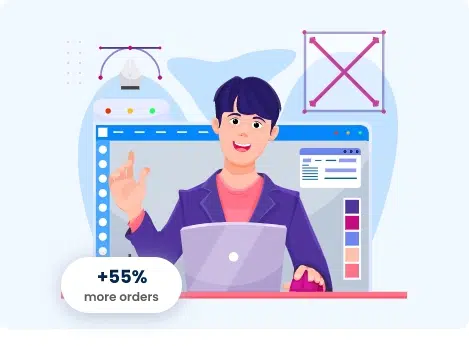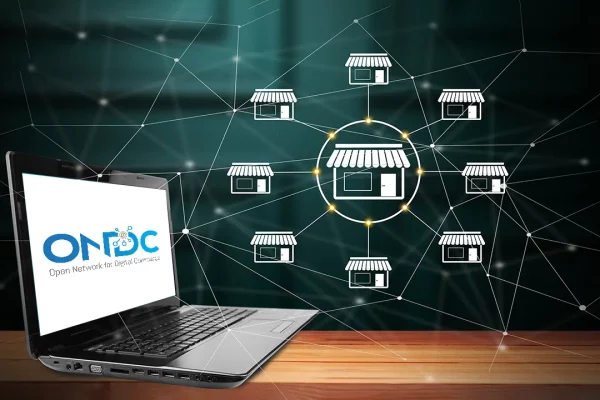What is an eCommerce Business?
eCommerce also known as electronic commerce or internet commerce, is all about buying and selling goods or services using the internet, and the transfer of money and data to execute these transactions.
As the online world continues to grow and it has a genuine distinct advantage, eCommerce Business becoming more popular within a short span of time. eCommerce Business already has and would evolve in profound ways in the coming years.
[elementor-template id=”40860″]
Why are eCommerce Businesses growing from strength to strength?

There are several factors contributing to the growth of eCommerce businesses:
Convenience: Shopping online offers customers the convenience of making purchases from the comfort of their own homes, 24/7. This has made eCommerce an increasingly popular option for people looking to buy products or services.
Increased Internet and Mobile Penetration: With the widespread availability of high-speed internet and the increasing use of smartphones, more and more people are turning to online shopping. This has created a massive market for eCommerce businesses.
Improved Shipping and Logistics: The growth of eCommerce has also led to improvements in shipping and logistics, with many businesses offering free or discounted shipping and improved delivery times.
Personalization: Many eCommerce businesses use data and technology to personalize the shopping experience for their customers. This can include personalized product recommendations, targeted promotions, and customized shopping experiences.
Competitive Prices: With many eCommerce businesses operating on thin margins, they often offer competitive prices that are difficult for brick-and-mortar stores to match.
Overall, the combination of convenience, technology, and competition is driving the growth of eCommerce businesses, and this trend is expected to continue in the future.
Retail eCommerce sales worldwide from 2014 to 2026
As life becomes more occupied and innovation changes and improves, purchasers are looking for new, more helpful strategies to satisfy their needs. Hence eCommerce Business Growth is becoming inevitable and at the same time, it is redefining commercial activities around the world.
Online retail spending across developing business sectors is growing past normal with an eCommerce Business, and if you’ve been thinking about eCommerce Business Ideas and want to venture a foot into its world of infinite profits with a proper eCommerce Business Plan then it’s never been a better time to start an online business.
Top 8 Reasons why eCommerce Business is becoming popular
In 2022 global eCommerce sales reached more than $5 trillion with over 2.14 billion online shoppers and 9.1 million online stores in the world. Making products available online increases the chances of selling them to a significantly higher number of people and at the same time supports business with brand awareness and promotion. Business gets more visibility to potential customers, therefore more people visit eCommerce store or get to hear about the brand, then buy the product and recommend them to others by leaving reviews or sharing their experience on social media. This way the business wins loyal customers across the globe and does not get limited to the local market. If you are still hesitating about whether to invest in the digital transformation of your eCommerce Business, here is a comprehensive list describing the most significant e-commerce benefits.
1. Increased Sales
eCommerce Businesses are not generally restricted to conventional store hours. When unlimited customers get access to the business 24*7/365. On the other hand, by going online, business isn’t limited to the local market or to physical store capacity, which would definitely generate more sales.
eCommerce Business would broaden the business horizons which would not only generate more revenue but would help the business grow globally and sell goods on the wider market. Positive eCommerce business growth leads to reinvestment opportunities or high profits for business owners to enjoy.
2. Reduced Operational Expenses
eCommerce Business is the most economical way to grow your retail business. It doesn’t require high investment and it’s cost-effective. Most of the investment is repaid by early sales profits.
Buying a domain and hosting or paying for web development and good eCommerce service and building your own eCommerce Business Website for sale is less expensive than buying or renting physical business premises. eCommerce business model is effective for all kinds of businesses small or big.
Any statistics report you find related to add the source or infographics
3. Increased Availability of Products
With products listed on the eCommerce Business Website, any business has a better chance to reach out to its customers and promote its business. The products get constant visibility as eCommerce platforms offer online listings and price comparisons. When businesses opt for eCommerce Business Website, it gives businesses limitless opportunities to present their items in a visually pleasing way and stand out from the crowd.
for what bases product availability increased show some bullet points
4. Simplified Buying Process
The most convenient aspect of the eCommerce Business Model is that the customer can purchase directly from you. When Customers expect goods to be available immediately without spending much time and traveling to a store, eCommerce Business Website is the best answer to that need.
how we are simplifying buying process
5. Automation
eCommerce Business offers full automation, including finance, inventory, shipping, and customer service which means everything is under one roof and can be easily managed by one person at their convenience. AI-enabled Chatbots would help businesses communicate with most inquiries with a personal touch.
When a Business Owner tends to make a living from his eCommerce Business, the only thing to have in mind is growth, growth, and more growth. Growth involves increasing revenue and average order value and attracting more customers to your eCommerce Business Website. Full automation in eCommerce Business Model would give Business Owners time to grow their businesses and keep customers happy at the same time.
How we are changed ecommerce business automation
6. Affordable Advertising & Marketing
Customer advocacy and increased brand awareness reduce advertising and marketing costs. In the age of the Internet, Businesses can reach their potential customers with every review of their product or opinion about their brand left on Google or other independent consumer review websites. Moreover, product listings on eCommerce platforms make goods visible to the potential customer. Products can be showcased using photos, videos, and banners. Once a business opts for an eCommerce business model, an entire set of affordable tools is available for businesses to promote their products. Not to mention eCommerce platforms are very well positioned in Google and the algorithms ensure eCommerce Businesses are ranked high in the search results.
7. Flexibility
Buying online gives customers the convenience of buying anywhere on the planet. Sellers can leverage this customer flexibility to build their revenue. They can sell through an eCommerce Business Website confidently knowing that there are plenty of buyers.
But it’s not just buyers, having an eCommerce Business also gives flexibility to sellers. Solutions like service automation or AI software give sellers more freedom while selling online and free time to further increase eCommerce sales or even start another business to supplement their income.
8. Analysis of Consumer Behaviour
Imagine being able to predict what and when will be bought from you and you would tailor your offer to each customer’s needs and guide them or make suggestions for buying certain products. Yes, with an eCommerce Business Website, businesses can achieve them but these cannot be entirely possible when the business is running a physical store only. While having an eCommerce Business Website a variety of analytics tools gives businesses insights into consumer buying habits and helps them not only personalize the offer but also respond quickly to their customer’s needs and changing trends. That’s one small step towards greater sales.
How is eCommerce Business taking over the market?
eCommerce Business has seen significant growth in recent years, due to the convenience and accessibility it offers to its customers, and the growth is expected to continue. This is due to increase convenience for both sellers and their shoppers and reducing friction in the buying (and selling) journey, providing rich & compelling shopping experiences, and enabling experiences across channels in a consistent, customer-friendly way.
At the same time, the purchasing power of the consumers is on track to account, and at the same time, the pandemic has also necessitated greater adoption of eCommerce, especially for essential items.
With the rise of the internet and mobile devices, shopping on mobile devices isn’t just a novelty anymore it has become easier for people to shop online from anywhere, at any time. That’s why mostly all eCommerce Businesses are optimizing for internet and mobile devices. In addition, the availability of a wide variety of products and competitive pricing has made eCommerce a viable option for many consumers. Sales using smartphones are expected to rise significantly, in 2022 it has crossed $432 billion.
As COVID-19 pushes customers further toward a digital-first world, there is increasing adoption of digital payment methods, such as online payment platforms and mobile payments. This has made it easier for customers to complete transactions online and has helped to increase the overall convenience of shopping online.
eCommerce Business Model allows businesses to sell to consumers anywhere in the world, providing access to a global market.
[elementor-template id=”40866″]
eCommerce Business Websites often provide tools for consumers to compare prices and features of different products, making it easier for them to make informed purchasing decisions.
Many eCommerce Business Websites use data about consumers’ past purchases and browsing history to make personalized recommendations, which can be helpful for consumers who are looking for something specific.
Finally, the proliferation of social media and online marketing has also helped to drive the growth of eCommerce. Many businesses have turned to social media and other online channels to promote their products and reach a wider audience.
Overall, the combination of convenience, accessibility, and a wide range of products and services has helped to drive the growth of eCommerce and make it a major force in the market.
Now that the technologies to create differentiated experiences are becoming more accessible, all kinds of businesses are looking to innovate. So to give customers the best possible experience eCommerce Businesses are working harder to provide rich, compelling shopping experiences that hold their customers’ attention in the crowded eCommerce market.
FAQ’s
[elementor-template id=”42921″]







